sensor VOLVO XC60 TWIN ENGINE 2019 Workshop Manual
[x] Cancel search | Manufacturer: VOLVO, Model Year: 2019, Model line: XC60 TWIN ENGINE, Model: VOLVO XC60 TWIN ENGINE 2019Pages: 695, PDF Size: 14.96 MB
Page 329 of 695
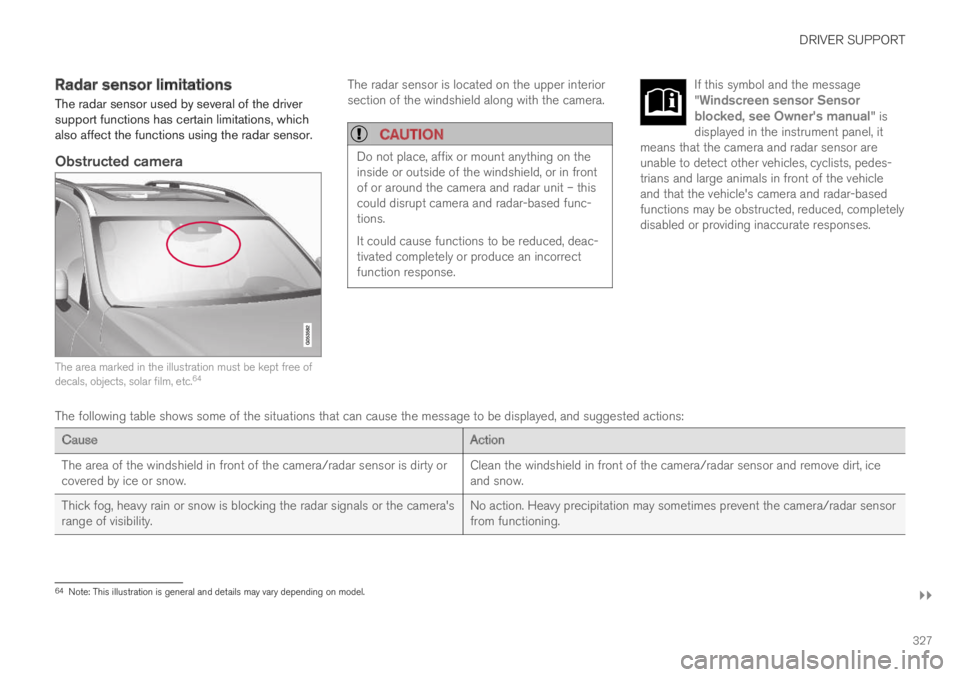
DRIVER SUPPORT
}}
327
Radar sensor limitations
The radar sensor used by several of the driversupport functions has certain limitations, whichalso affect the functions using the radar sensor.
Obstructed camera
The area marked in the illustration must be kept free ofdecals, objects, solar film, etc.64
The radar sensor is located on the upper interiorsection of the windshield along with the camera.
CAUTION
Do not place, affix or mount anything on theinside or outside of the windshield, or in frontof or around the camera and radar unit – thiscould disrupt camera and radar-based func-tions.
It could cause functions to be reduced, deac-tivated completely or produce an incorrectfunction response.
If this symbol and the message"Windscreen sensor Sensorblocked, see Owner's manual" isdisplayed in the instrument panel, itmeans that the camera and radar sensor areunable to detect other vehicles, cyclists, pedes-trians and large animals in front of the vehicleand that the vehicle's camera and radar-basedfunctions may be obstructed, reduced, completelydisabled or providing inaccurate responses.
The following table shows some of the situations that can cause the message to be displayed, and suggested actions:
CauseAction
The area of the windshield in front of the camera/radar sensor is dirty orcovered by ice or snow.Clean the windshield in front of the camera/radar sensor and remove dirt, iceand snow.
Thick fog, heavy rain or snow is blocking the radar signals or the camera'srange of visibility.No action. Heavy precipitation may sometimes prevent the camera/radar sensorfrom functioning.
64Note: This illustration is general and details may vary depending on model.
Page 330 of 695

||
DRIVER SUPPORT
328
CauseAction
Water or snow is spraying/swirling up and blocking the radar signals orthe camera's range of visibility.No action. Very wet or snow-covered roads may sometimes prevent the cam-era/radar sensor from functioning.
There is dirt between the inside of the windshield and the camera/radarsensor.Consult a workshop to have the area of the windshield on the inside of the cam-era's casing cleaned. An authorized Volvo workshop is recommended.
NOTE
Keep the windshield in front of the cameraand radar unit clean.
Vehicle speed
The radar sensor's ability to detect a vehicleahead is significantly reduced if:
the speed of the vehicle ahead differs greatlyfrom your vehicle's speed
Limited field of vision
The radar sensor has a limited field of vision. Insome situations, it may detect a vehicle later thanexpected or not at all.
The radar sensor's field of vision.
The radar sensor's detection of vehicles veryclose to your vehicle may be delayed in cer-tain situations, e.g. if a vehicle pulls in
between your vehicle and the vehicle directlyahead.
Small vehicles, such as motorcycles, or vehi-cles that are not driving in the center of thelane may remain undetected.
In curves, the radar may detect the wrongvehicle or lose sight of a target vehicle.
Low trailers
Low trailer in the radar shadow.
Low trailers may also be difficult or even impossi-ble for the radar to detect. The driver should beextra alert when driving behind vehicles towinglow trailers when Adaptive Cruise Control or PilotAssist is activated.
Page 331 of 695
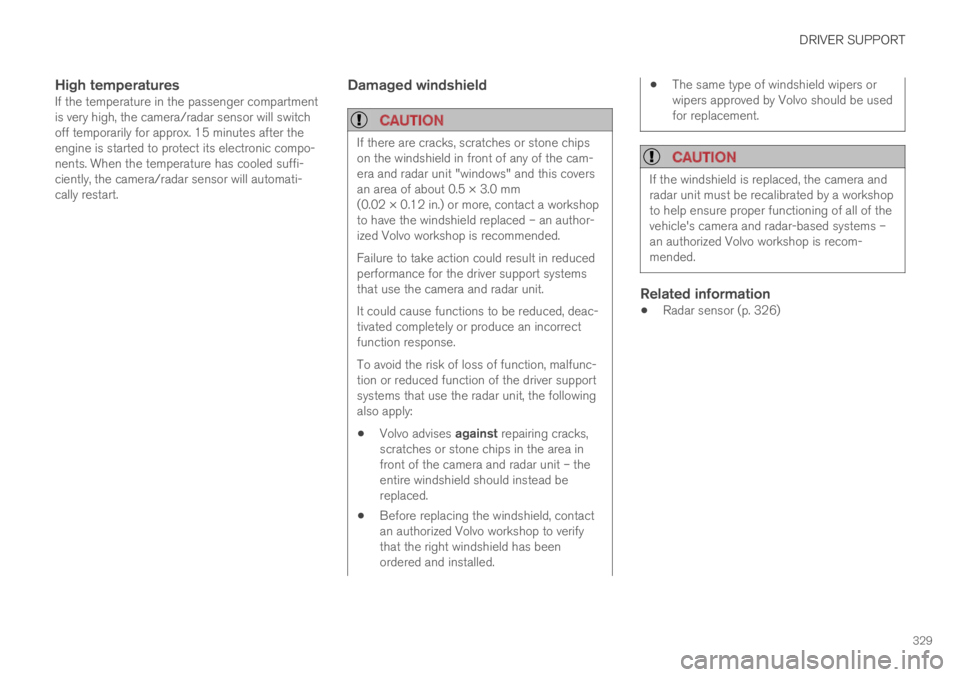
DRIVER SUPPORT
329
High temperatures
If the temperature in the passenger compartmentis very high, the camera/radar sensor will switchoff temporarily for approx. 15 minutes after theengine is started to protect its electronic compo-nents. When the temperature has cooled suffi-ciently, the camera/radar sensor will automati-cally restart.
Damaged windshield
CAUTION
If there are cracks, scratches or stone chipson the windshield in front of any of the cam-era and radar unit "windows" and this coversan area of about 0.5 × 3.0 mm(0.02 × 0.12 in.) or more, contact a workshopto have the windshield replaced – an author-ized Volvo workshop is recommended.
Failure to take action could result in reducedperformance for the driver support systemsthat use the camera and radar unit.
It could cause functions to be reduced, deac-tivated completely or produce an incorrectfunction response.
To avoid the risk of loss of function, malfunc-tion or reduced function of the driver supportsystems that use the radar unit, the followingalso apply:
Volvo advises against repairing cracks,scratches or stone chips in the area infront of the camera and radar unit – theentire windshield should instead bereplaced.
Before replacing the windshield, contactan authorized Volvo workshop to verifythat the right windshield has beenordered and installed.
The same type of windshield wipers orwipers approved by Volvo should be usedfor replacement.
CAUTION
If the windshield is replaced, the camera andradar unit must be recalibrated by a workshopto help ensure proper functioning of all of thevehicle's camera and radar-based systems –an authorized Volvo workshop is recom-mended.
Related information
Radar sensor (p. 326)
Page 332 of 695
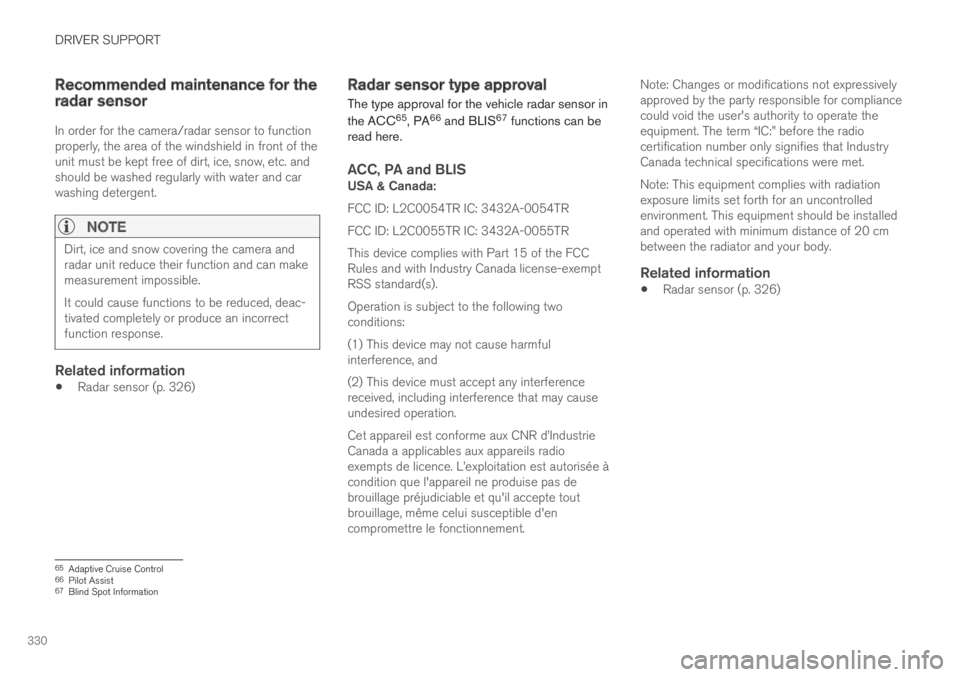
DRIVER SUPPORT
330
Recommended maintenance for theradar sensor
In order for the camera/radar sensor to functionproperly, the area of the windshield in front of theunit must be kept free of dirt, ice, snow, etc. andshould be washed regularly with water and carwashing detergent.
NOTE
Dirt, ice and snow covering the camera andradar unit reduce their function and can makemeasurement impossible.
It could cause functions to be reduced, deac-tivated completely or produce an incorrectfunction response.
Related information
Radar sensor (p. 326)
Radar sensor type approval
The type approval for the vehicle radar sensor in
the ACC65, PA66 and BLIS67 functions can beread here.
ACC, PA and BLIS
USA & Canada:
FCC ID: L2C0054TR IC: 3432A-0054TR
FCC ID: L2C0055TR IC: 3432A-0055TR
This device complies with Part 15 of the FCCRules and with Industry Canada license-exemptRSS standard(s).
Operation is subject to the following twoconditions:
(1) This device may not cause harmfulinterference, and
(2) This device must accept any interferencereceived, including interference that may causeundesired operation.
Cet appareil est conforme aux CNR d
Page 333 of 695
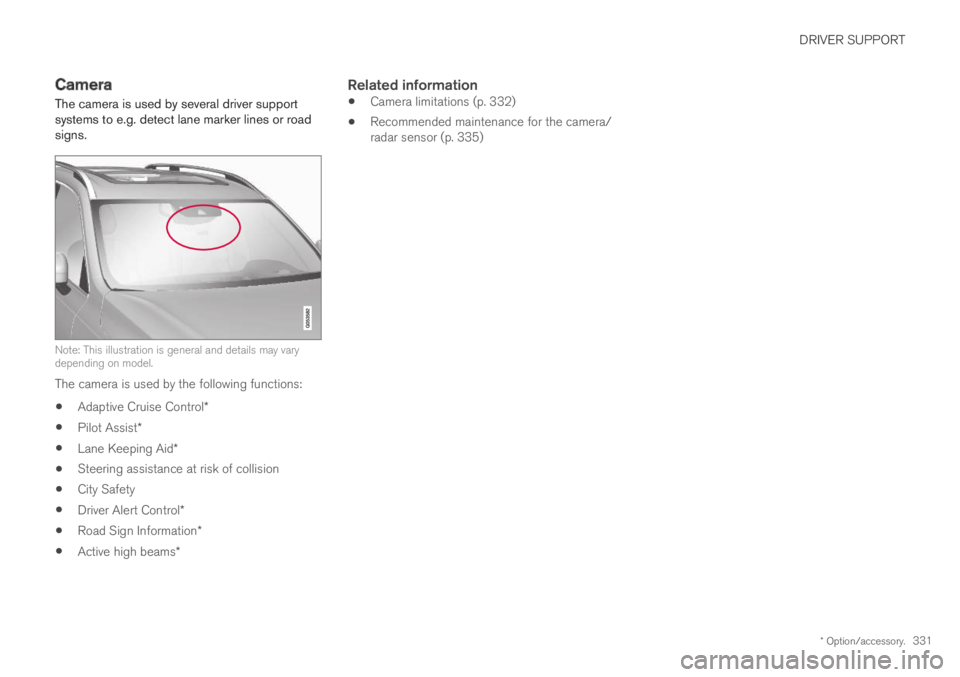
DRIVER SUPPORT
* Option/accessory.331
Camera
The camera is used by several driver supportsystems to e.g. detect lane marker lines or roadsigns.
Note: This illustration is general and details may varydepending on model.
The camera is used by the following functions:
Adaptive Cruise Control*
Pilot Assist*
Lane Keeping Aid*
Steering assistance at risk of collision
City Safety
Driver Alert Control*
Road Sign Information*
Active high beams*
Related information
Camera limitations (p. 332)
Recommended maintenance for the camera/radar sensor (p. 335)
Page 335 of 695
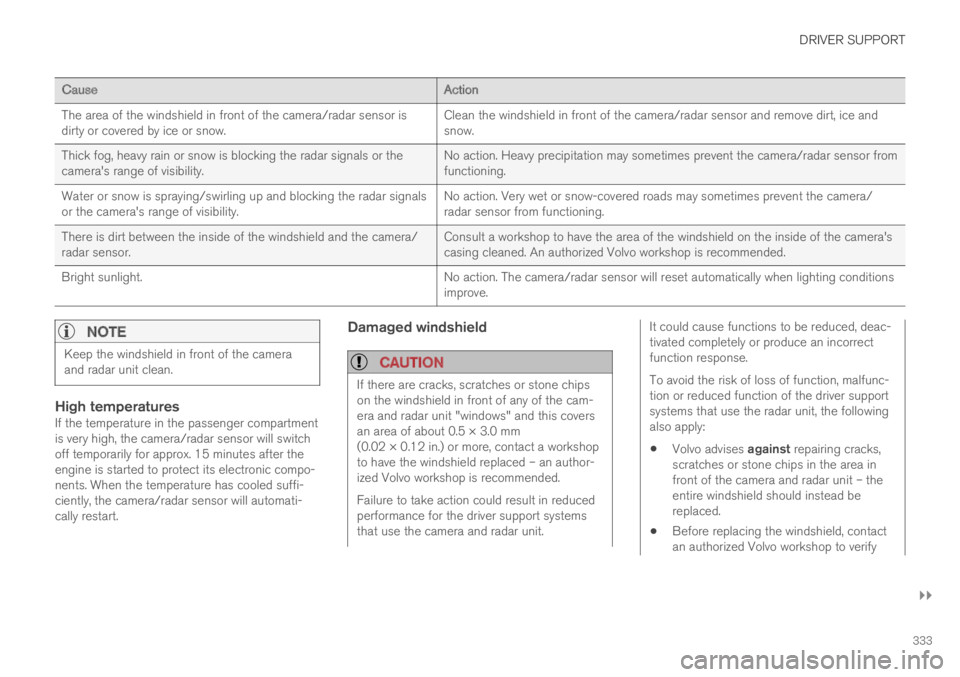
DRIVER SUPPORT
}}}}
333
CauseAction
The area of the windshield in front of the camera/radar sensor isdirty or covered by ice or snow.Clean the windshield in front of the camera/radar sensor and remove dirt, ice andsnow.
Thick fog, heavy rain or snow is blocking the radar signals or thecamera's range of visibility.No action. Heavy precipitation may sometimes prevent the camera/radar sensor fromfunctioning.
Water or snow is spraying/swirling up and blocking the radar signalsor the camera's range of visibility.No action. Very wet or snow-covered roads may sometimes prevent the camera/radar sensor from functioning.
There is dirt between the inside of the windshield and the camera/radar sensor.Consult a workshop to have the area of the windshield on the inside of the camera'scasing cleaned. An authorized Volvo workshop is recommended.
Bright sunlight.No action. The camera/radar sensor will reset automatically when lighting conditionsimprove.
NOTE
Keep the windshield in front of the cameraand radar unit clean.
High temperatures
If the temperature in the passenger compartmentis very high, the camera/radar sensor will switchoff temporarily for approx. 15 minutes after theengine is started to protect its electronic compo-nents. When the temperature has cooled suffi-ciently, the camera/radar sensor will automati-cally restart.
Damaged windshield
CAUTION
If there are cracks, scratches or stone chipson the windshield in front of any of the cam-era and radar unit "windows" and this coversan area of about 0.5 × 3.0 mm(0.02 × 0.12 in.) or more, contact a workshopto have the windshield replaced – an author-ized Volvo workshop is recommended.
Failure to take action could result in reducedperformance for the driver support systemsthat use the camera and radar unit.
It could cause functions to be reduced, deac-tivated completely or produce an incorrectfunction response.
To avoid the risk of loss of function, malfunc-tion or reduced function of the driver supportsystems that use the radar unit, the followingalso apply:
Volvo advises against repairing cracks,scratches or stone chips in the area infront of the camera and radar unit – theentire windshield should instead bereplaced.
Before replacing the windshield, contactan authorized Volvo workshop to verify
Page 337 of 695
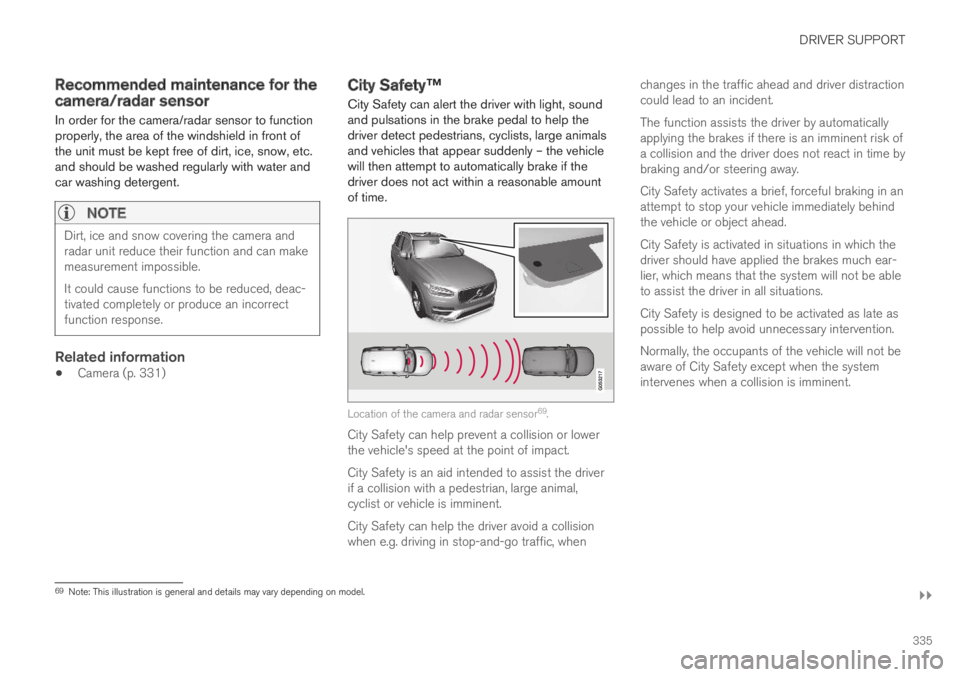
DRIVER SUPPORT
}}
335
Recommended maintenance for thecamera/radar sensor
In order for the camera/radar sensor to functionproperly, the area of the windshield in front ofthe unit must be kept free of dirt, ice, snow, etc.and should be washed regularly with water andcar washing detergent.
NOTE
Dirt, ice and snow covering the camera andradar unit reduce their function and can makemeasurement impossible.
It could cause functions to be reduced, deac-tivated completely or produce an incorrectfunction response.
Related information
Camera (p. 331)
City Safety™
City Safety can alert the driver with light, soundand pulsations in the brake pedal to help thedriver detect pedestrians, cyclists, large animalsand vehicles that appear suddenly – the vehiclewill then attempt to automatically brake if thedriver does not act within a reasonable amountof time.
Location of the camera and radar sensor69.
City Safety can help prevent a collision or lowerthe vehicle's speed at the point of impact.
City Safety is an aid intended to assist the driverif a collision with a pedestrian, large animal,cyclist or vehicle is imminent.
City Safety can help the driver avoid a collisionwhen e.g. driving in stop-and-go traffic, when
changes in the traffic ahead and driver distractioncould lead to an incident.
The function assists the driver by automaticallyapplying the brakes if there is an imminent risk ofa collision and the driver does not react in time bybraking and/or steering away.
City Safety activates a brief, forceful braking in anattempt to stop your vehicle immediately behindthe vehicle or object ahead.
City Safety is activated in situations in which thedriver should have applied the brakes much ear-lier, which means that the system will not be ableto assist the driver in all situations.
City Safety is designed to be activated as late aspossible to help avoid unnecessary intervention.
Normally, the occupants of the vehicle will not beaware of City Safety except when the systemintervenes when a collision is imminent.
69Note: This illustration is general and details may vary depending on model.
Page 339 of 695
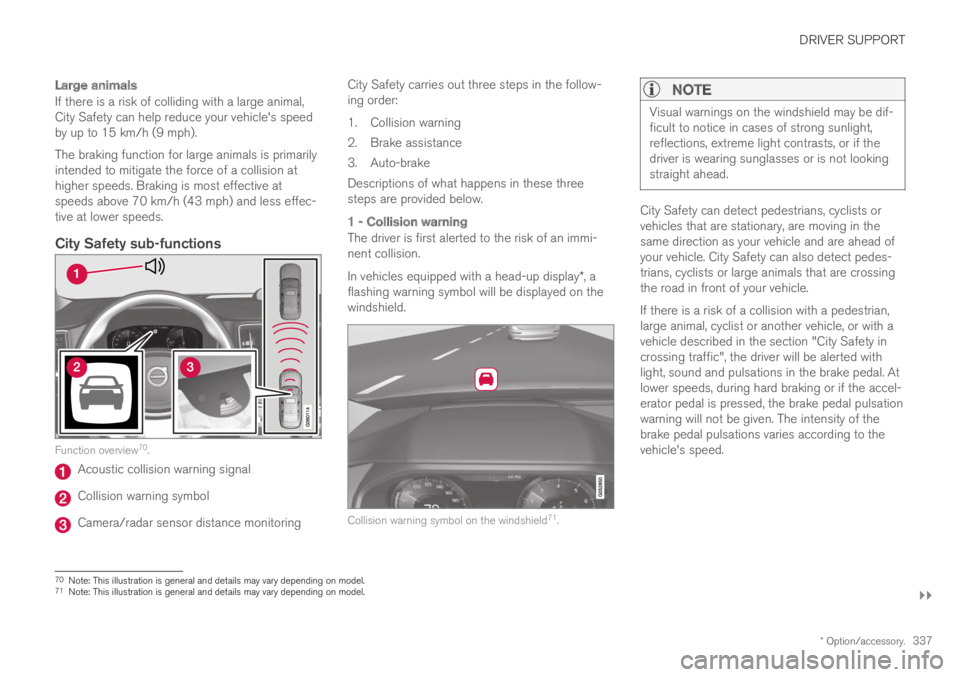
DRIVER SUPPORT
}}
* Option/accessory.337
Large animals
If there is a risk of colliding with a large animal,City Safety can help reduce your vehicle's speedby up to 15 km/h (9 mph).
The braking function for large animals is primarilyintended to mitigate the force of a collision athigher speeds. Braking is most effective atspeeds above 70 km/h (43 mph) and less effec-tive at lower speeds.
City Safety sub-functions
Function overview70.
Acoustic collision warning signal
Collision warning symbol
Camera/radar sensor distance monitoring
City Safety carries out three steps in the follow-ing order:
1.Collision warning
2. Brake assistance
3. Auto-brake
Descriptions of what happens in these threesteps are provided below.
1 - Collision warning
The driver is first alerted to the risk of an immi-nent collision.
In vehicles equipped with a head-up display*, aflashing warning symbol will be displayed on thewindshield.
Collision warning symbol on the windshield71.
NOTE
Visual warnings on the windshield may be dif-ficult to notice in cases of strong sunlight,reflections, extreme light contrasts, or if thedriver is wearing sunglasses or is not lookingstraight ahead.
City Safety can detect pedestrians, cyclists orvehicles that are stationary, are moving in thesame direction as your vehicle and are ahead ofyour vehicle. City Safety can also detect pedes-trians, cyclists or large animals that are crossingthe road in front of your vehicle.
If there is a risk of a collision with a pedestrian,large animal, cyclist or another vehicle, or with avehicle described in the section "City Safety incrossing traffic", the driver will be alerted withlight, sound and pulsations in the brake pedal. Atlower speeds, during hard braking or if the accel-erator pedal is pressed, the brake pedal pulsationwarning will not be given. The intensity of thebrake pedal pulsations varies according to thevehicle's speed.
70Note: This illustration is general and details may vary depending on model.71Note: This illustration is general and details may vary depending on model.
Page 344 of 695
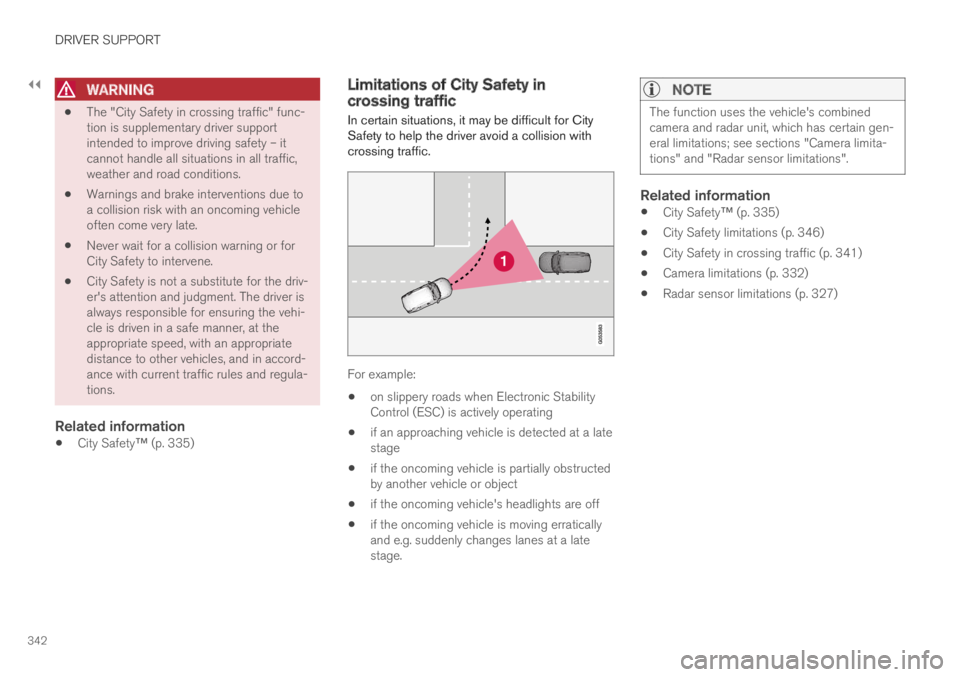
||
DRIVER SUPPORT
342
WARNING
The "City Safety in crossing traffic" func-tion is supplementary driver supportintended to improve driving safety – itcannot handle all situations in all traffic,weather and road conditions.
Warnings and brake interventions due toa collision risk with an oncoming vehicleoften come very late.
Never wait for a collision warning or forCity Safety to intervene.
City Safety is not a substitute for the driv-er's attention and judgment. The driver isalways responsible for ensuring the vehi-cle is driven in a safe manner, at theappropriate speed, with an appropriatedistance to other vehicles, and in accord-ance with current traffic rules and regula-tions.
Related information
City Safety™ (p. 335)
Limitations of City Safety incrossing traffic
In certain situations, it may be difficult for CitySafety to help the driver avoid a collision withcrossing traffic.
For example:
on slippery roads when Electronic StabilityControl (ESC) is actively operating
if an approaching vehicle is detected at a latestage
if the oncoming vehicle is partially obstructedby another vehicle or object
if the oncoming vehicle's headlights are off
if the oncoming vehicle is moving erraticallyand e.g. suddenly changes lanes at a latestage.
NOTE
The function uses the vehicle's combinedcamera and radar unit, which has certain gen-eral limitations; see sections "Camera limita-tions" and "Radar sensor limitations".
Related information
City Safety™ (p. 335)
City Safety limitations (p. 346)
City Safety in crossing traffic (p. 341)
Camera limitations (p. 332)
Radar sensor limitations (p. 327)
Page 345 of 695
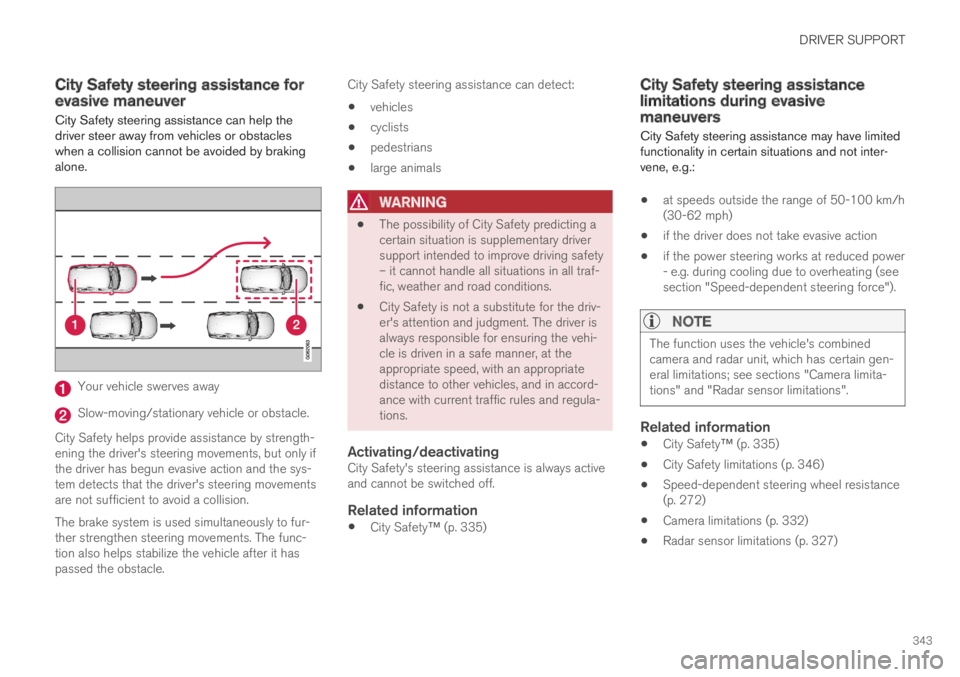
DRIVER SUPPORT
343
City Safety steering assistance forevasive maneuver
City Safety steering assistance can help thedriver steer away from vehicles or obstacleswhen a collision cannot be avoided by brakingalone.
Your vehicle swerves away
Slow-moving/stationary vehicle or obstacle.
City Safety helps provide assistance by strength-ening the driver's steering movements, but only ifthe driver has begun evasive action and the sys-tem detects that the driver's steering movementsare not sufficient to avoid a collision.
The brake system is used simultaneously to fur-ther strengthen steering movements. The func-tion also helps stabilize the vehicle after it haspassed the obstacle.
City Safety steering assistance can detect:
vehicles
cyclists
pedestrians
large animals
WARNING
The possibility of City Safety predicting acertain situation is supplementary driversupport intended to improve driving safety– it cannot handle all situations in all traf-fic, weather and road conditions.
City Safety is not a substitute for the driv-er's attention and judgment. The driver isalways responsible for ensuring the vehi-cle is driven in a safe manner, at theappropriate speed, with an appropriatedistance to other vehicles, and in accord-ance with current traffic rules and regula-tions.
Activating/deactivating
City Safety's steering assistance is always activeand cannot be switched off.
Related information
City Safety™ (p. 335)
City Safety steering assistancelimitations during evasivemaneuvers
City Safety steering assistance may have limitedfunctionality in certain situations and not inter-vene, e.g.:
at speeds outside the range of 50-100 km/h(30-62 mph)
if the driver does not take evasive action
if the power steering works at reduced power- e.g. during cooling due to overheating (seesection "Speed-dependent steering force").
NOTE
The function uses the vehicle's combinedcamera and radar unit, which has certain gen-eral limitations; see sections "Camera limita-tions" and "Radar sensor limitations".
Related information
City Safety™ (p. 335)
City Safety limitations (p. 346)
Speed-dependent steering wheel resistance(p. 272)
Camera limitations (p. 332)
Radar sensor limitations (p. 327)